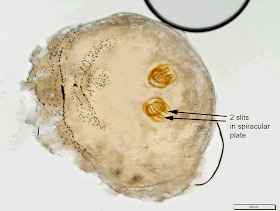Answer: Fly larvae (maggots). You can tell that these are second instars because they only have 2 spiracular slits rather than 3. It is difficult to identify early instars to the genus level, given the lack of available literature. For the 3rd instar larvae, important identifying features include the mouth parts, posterior spiracles, body shape and arrangement of cuticular spines. You can often view the spiracles using only a stereomicroscope, although in this case, I cut off the posterior end and mounted it on a glass slide.
In this case, I can tell you that these are specifically blowfly larvae; Lucilia (Phaenicia) sericata; also sold as Medical Maggots (TM), since they were purchased by my institution. These maggots are actually cleared by the FDA for "debriding chronic wounds such as pressure ulcers, venous stasis ulcers, neuropathic foot ulcers and non-healing traumatic or post surgical wounds." Since they ingest only dead tissue, they offer a very effective means of wound debridement.
When ordered, they come in a small gauze, which is applied directly to the wound and then covered with a dressing. The instructions warn that after consuming the dead tissue, the maggots may migrate outside of the dressing, which can be a significant cause of consternation for the patient and nursing staff! Here is a link to some great information on maggot therapy.

No comments:
Post a Comment